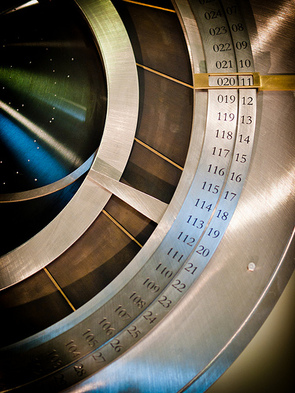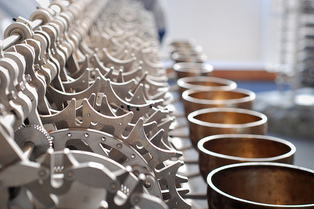 Clock of the Long now (CC BY-NC-ND 2.0 Piglicker) Clock of the Long now (CC BY-NC-ND 2.0 Piglicker) Originally published on the Time of Encounter blog, part of an AHRC funded project exploring social aspects of time. The Doomsday Clock and the 100 month clock both encourage a shift away from the idea that the future is something that automatically happens. Moving from a numbered time to one based on the qualities of that time, both suggest that unless we make significant changes in the present, there might not even be a future for the human race (and for most other life on this planet). In this post though, I want to look at the Clock of the Long Now, which offers quite a different perspective. Here the concern is not that we take the future for granted, but rather that we take no notice of it at all. So rather than having a clock that frames time within a twelve hour period, or a calender that frames time within a year, the Clock of the Long Now is being built to last for 10,000 years. First proposed by scientist and inventor Danny Hillis, this clock does not mark every second, or even every minute, instead it is one that “ticks once a year. The century hand advances once every 100 years, and the cuckoo comes out on the millennium”. This long sense of time is not (like the previous two clocks discussed) intended to produce a sense of the devastating consequences of our current way of life, but instead, to start to imagine what could be accomplished over long periods of time with continued effort. The concern with taking a longer view was partly to counteract the very short term thinking that Hillis noticed within I.T. projects. For example, when a very early computer was shut down at M.I.T. all the information had to be moved to magnetic tapes which can no longer be read. This meant that “we lost the world’s first text editor, the first vision and language programs, and the early correspondence of the founders of artificial intelligence” (Brand 1999, 84). As Steward Brand, another co-founder of the project commented, “science historians can read Galileo’s technical correspondence from the 1590s but not Marvin Minsky’s from the 1960s”. In starting to think through the design problems involved with building a device that would last for 10,000 years, it’s interesting that Hillis’ awareness of the ability for low tech methods to last, where high tech fails, has meant that the progressive narrative of a continuously technologically advancing future had to be seriously questioned. Instead, when you have to think about the future in much more specific ways, e.g. how to make a particular physical device operate for an extended length of time, the unknowability of the future becomes much more pronounced. Instead of trusting that things will always improve, as so many ‘return to growth’ advocates do, the desire to make something last actually seems to bring out a more cautious approach (see also “Into Eternity”). Not knowing what the future held meant that the key design principles had to be based on the idea that people in the future might not have the knowledge or the materials to deal with a device built using our current technology. So the clock had to be able to be maintained using technologies available during the Bronze age, but also had to be ‘transparent’. That is, the clock mechanisms should be able to be figured out by an intelligent person only by observing the mechanism itself.  Mechanism on prototype (CC BY-NC 2.0 Madichan) Mechanism on prototype (CC BY-NC 2.0 Madichan) Hillis’ interest in Bronze Age technology was criticised by futurists who understood the clock as a reversion to the past, rather than showing us the future. This in itself is interesting since it shows quite clearly how inbuilt the assumption of progress is, even with those who devote their careers to thinking about time and the future. A further question they posed though is more interesting. According to Po Bronson, “in their opinion, by demonstrating the technology of the past, the clock will make us think about the past”. That is, in the future will the clock still make people think of the times ahead or would it instead make people think more “about what life was like in 2000, and wonder why in the world someone way back then would build such a thing.” But perhaps the focus on whether the clock tells us about the past or the future is to slightly miss the point, since these criticisms still use a framework of time-as-we-know-it. That is, the conception of time being drawn on in the criticisms has not itself been called into question. The Clock of the Long Now is not necessarily telling ‘our time’ rather it is trying to connect us up with ‘deep time’, arguably a fundamentally different kind of time. Can progress and regress really mean the same thing when thought about in the context of tens or hundreds of thousands of years? More importantly does it matter if people in the year 4000 (or 04000) are thinking about us in the 2000s rather than those in 6000s? It seems that one of the key points of the clock is that the kinds of relations produced by a standard clock, where we are often only thinking about those close in time to ourselves, are transformed. The triumph will be if people divided from each other by millennia are thinking about each other at all… Reference Brand, Stewart. 2000. The Clock Of The Long Now: Time and Responsibility. New York: Basic Books. Comments are closed.
|
Archives
November 2022
Categories
All
|
 RSS Feed
RSS Feed
